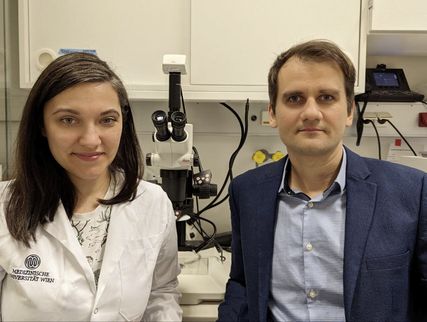
Neuroblastoma: Of mice and men
Polina Kameneva, PhD
Abteilung für Neuroimmunologie,
Zentrum für Hirnforschung, MedUni Wien
E-Mail: polina.kameneva@meduniwien.ac.at
Artem Artemov, PhD
Principal Scientist, present address: Boehringer Ingelheim
E-Mail: artem.v.artemov@gmail.com
Das Interview führte
Ingeborg Morawetz, MA
Polina Kameneva, PhD, and Artem Artemov, PhD, both did neuroimmunological research at Medizinische Universität Wien. They engaged in the analysis of one of the most common extracranial cancer types in newborns: the neuroblastoma. An important result so far is the need for distinction between species.
How did your research project come about?
The adrenal gland is a fascinating organ that provides vital hormones and regulates many physiological functions and our behavior. For example, stress response or love for extreme sports are dependent on the adrenalin and noradrenalin released by chromaffin cells populating the adrenal gland medulla. Unfortunately, the adrenal gland medulla is also a common place where one of the deadliest pediatric cancers – neuroblastoma – is found.
Heureka-Moment: Junge Forschende stellen sich vor
Heute: Polina Kameneva, PhD und Artem Artemov, PhDThe current view is that neuroblastoma emerges when a process of cell differentiation goes awry and it is our biggest motivation to uncover the mysteries of the disease through investigation of the adrenal gland development. Neuroblastoma is composed of sympathetic neuroblasts, which are a sister population to the chromaffin cells in the developmental context. In this realm, one of the breakthroughs in Univ.-Prof. Dr. Igor Adameyko’s lab was the discovery of the nerve-dependent origin of chromaffin cells through the special population of transient cells which travel along the nerves in developing organisms and give rise to various cell types, including chromaffin cells.
Sympathoblasts rarely develop from nerve-associated cells and, therefore, the connection between these two cell types for neuroblastoma origin remained unclear. With this study, we wanted to have a close look at the development of the human adrenal gland and to assess if through that we could get an insight into neuroblastoma pathology.
Which of the gained insights was the most important?
We applied state-of-the-art single-cell transcriptomics analysis and carefully validated the results by looking for specific cell types within the tissue across several developmental stages. This study is a comprehensive atlas of the complete adrenal gland development including the adrenal cortex and vascular systems. Focusing on the adrenal gland medulla with implications for neuroblastoma development we found two critical insights.
First, there is a large number of sympathetic neuroblasts inside the human adrenal gland, unlike in the adrenal glands of mice. Second, in humans, these sympathetic neuroblasts originate from nerve-associated glial cells together with chromaffin cells and, additionally, they can turn into chromaffin cells themselves during development.
These observations bring up new possibilities that the developing nerves may serve as a niche for cancer precursor cells and that the disruption of the sympathoblasts’ conversion to chromaffin cells may be involved in neuroblastoma pathology. Current efforts to obtain the models of human adrenal gland development are instrumental for functional validations of this hypothesis and for translating these findings for novel therapeutic strategies.
Which of the gained insights was the most surprising?
The biggest surprise we faced during the study of the development of the human adrenal gland was how little we could translate the knowledge from the research in mice to humans. To distinguish sympathoblasts cells, researchers traditionally used the expression of the CARTPT gene as a marker. This worked well in mice, however, it did not work in humans.
A previous paper on human adrenal gland development from a competitor group used CARTPT to annotate sympathoblasts, however, this gene was not expressed in human sympathoblasts. Quite the opposite, CARTPT was expressed in the other cell type of the adrenal gland — chromaffin cells. Reliance on CARTPT as a marker led to the misannotation of chromaffin cells as sympathoblasts, which in turn led to identification of the wrong cell type as a cell of origin in neuroblastoma.
In our work, we attempted to look at a longer list of marker genes for sympathoblasts and chromatin cells – which gave us a more comprehensive view of their identity and demonstrated that CARTPT expression in evolution indeed jumped from one cell type to another. This settled the ongoing debate in the community.
Overall, this story is a good reminder of how careful one should be when generalizing the results obtained in mice and other model organisms to humans, especially in the realm of the development of nervous system and neural crest derivatives and even more so in the development of new therapies.
The interview reflects the own opinions of the participants and not of the organizations they are affiliated with.
Das könnte Sie auch interessieren:
Erhaltungstherapie mit Atezolizumab nach adjuvanter Chemotherapie
Die zusätzliche adjuvante Gabe von Atezolizumab nach kompletter Resektion und adjuvanter Chemotherapie führte in der IMpower010-Studie zu einem signifikant verlängerten krankheitsfreien ...
Highlights zu Lymphomen
Assoc.Prof. Dr. Thomas Melchardt, PhD zu diesjährigen Highlights des ASCO und EHA im Bereich der Lymphome, darunter die Ergebnisse der Studien SHINE und ECHELON-1
Aktualisierte Ergebnisse für Blinatumomab bei neu diagnostizierten Patienten
Die Ergebnisse der D-ALBA-Studie bestätigen die Chemotherapie-freie Induktions- und Konsolidierungsstrategie bei erwachsenen Patienten mit Ph+ ALL. Mit einer 3-jährigen ...



